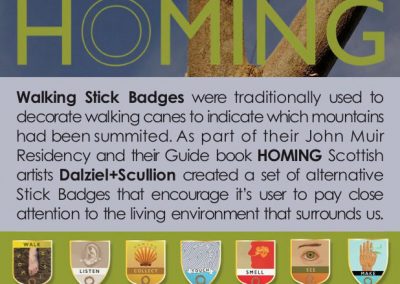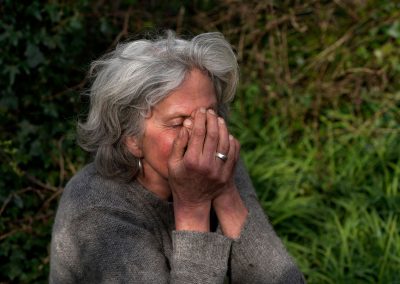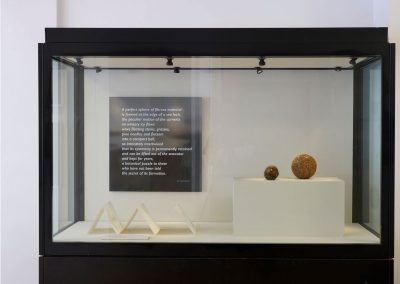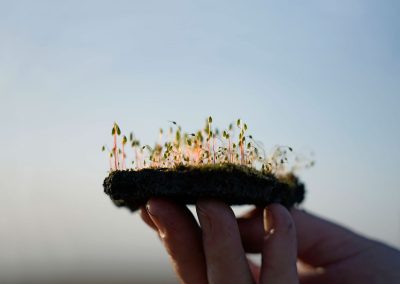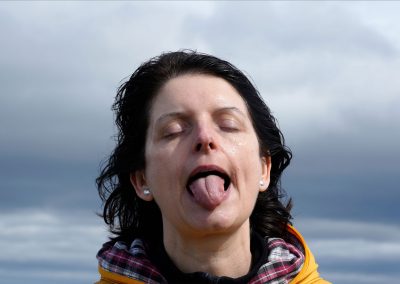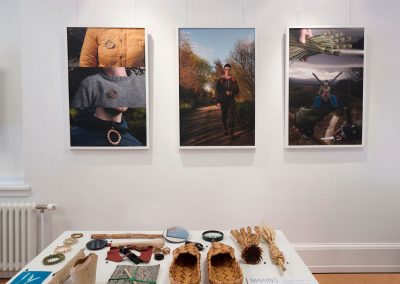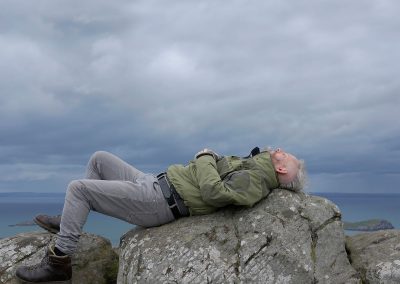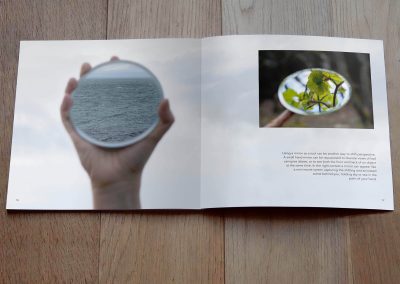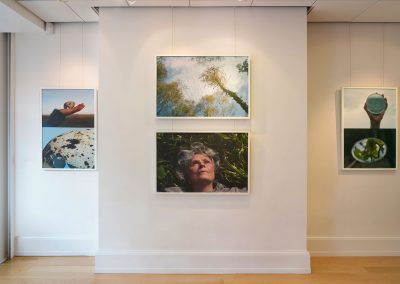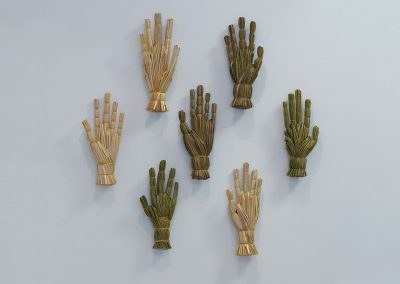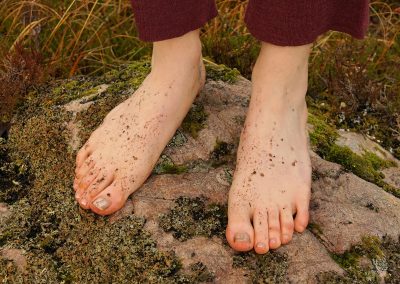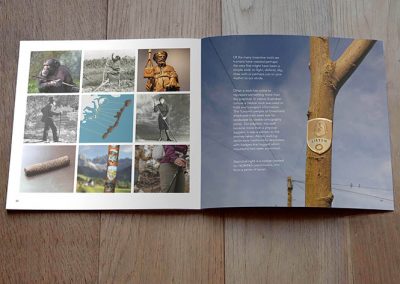JOHN MUIR RESIDENCY | DALZIEL+SCULLION
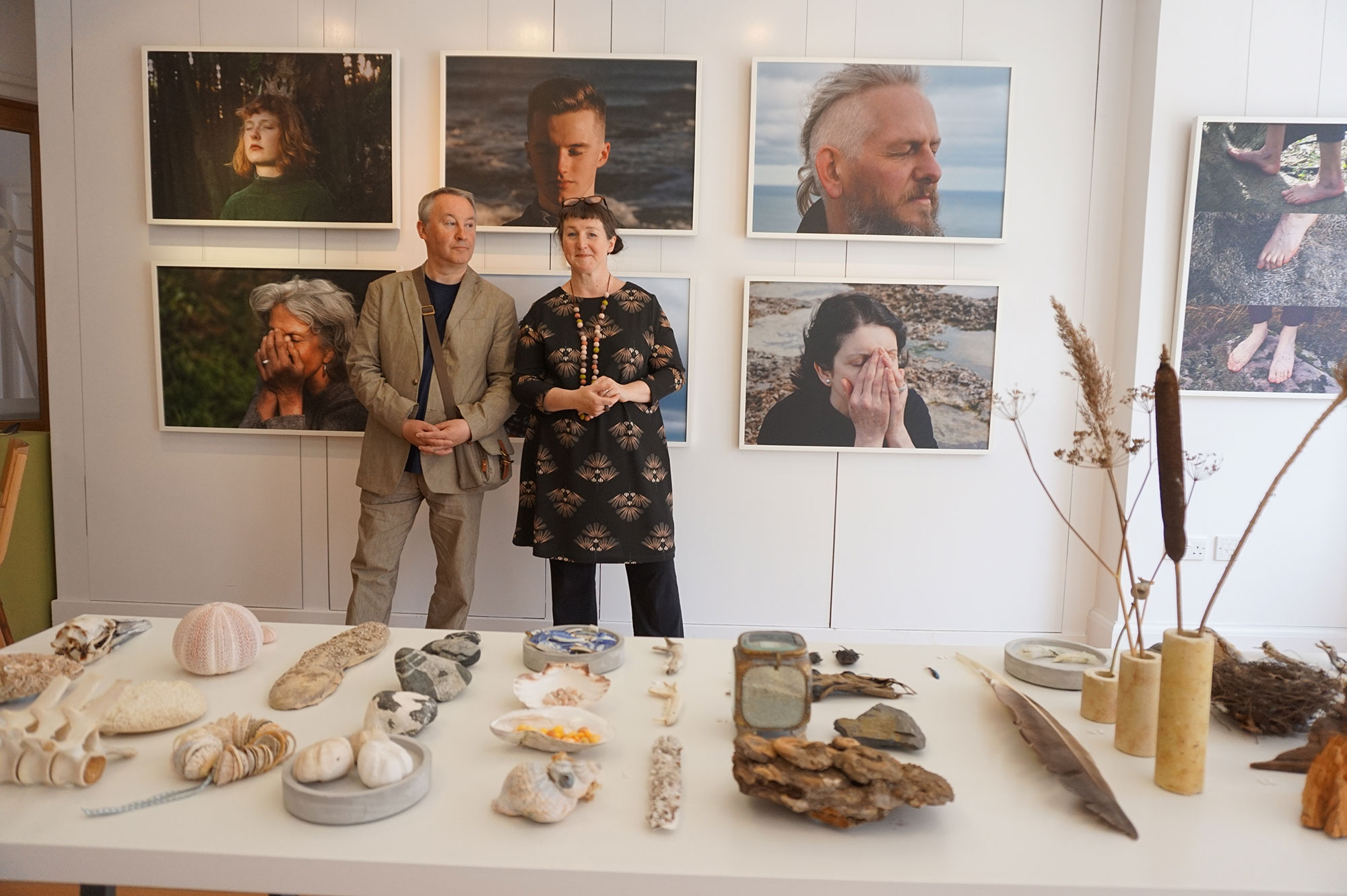
In order to throw themselves into the local area Dalziel+Scullion walked some of the John Muir Way and took part in local events meeting people and getting a sense of the specific nature of this place. As they worked initially they were focusing on one particular species but as time went on their practice evolved: local people took part in a photographic day that would appear in the exhibition. Later they chose to develop a book following their decision to try and leave as little footprint on the earth as they could, which was central to their concerns.
HOMING became an extremely personal way of installing their exhibition at Dunbar Town House Gallery, which was extremely well received. As well as the beautiful photographs of local people, a mark of Dalziel+Scullion’s work, some very personal possessions were displayed: Things they had collected from nature over many years that held very significant meaning were meticulously laid out. With the help of a crafts woman they also designed a 3d woven hand to symbolise the hands on nature of the landscape of East Lothian. In the back of the book they included the 3d instructions to make the hand they had designed, made from reeds, which was devised. They also designed the collectable illustrated set of metal walking stick badges.
North Light Arts ran a workshop in the grammar school talking about the exhibition and making reed badges, which Dalziel+Scullion had designed – in past different badges would be worn to symbolise a person’s profession. An open workshop, help at the Town House, saw people following the instructions to make one of the reed hands.
With an artists talk they then presented their book HOMING at an evening, which was extremely successful. They were to call the book a sort of guide to our return to nature and they explained their process in a short film.
The book HOMING is available by contacting us here.
HOMING introduction by Euan McArthur
The title Homing is concise yet rich. It alludes to the ‘homing instinct’, the innate ability of animals to find their way back to their birthplace; and to ‘homing in’, to close In on a target. Both senses are relevant, and together they suggest an even more apposite sense: to intentionally home in on the sustaining life-world, which is our home. Home, in this book, is ‘nature’ understood in its everyday meaning of the organic world of animals and plants, land and sea, day and night, weather and seasons; the world which, despite human impacts of innumerable kind sand scales, comes before us and sustains us. The notion of homing in on home, then, implies, first, the recognition of the natural world as home, and second, to get close to it – or rather, to be in it, to feel ourselves part of it
Dalziel+Scullion call the book a “field guide for reconnecting with nature”. It has the practical character which that suggests, but it is held together by an argument and an ethos. The argument is that, over several centuries, most human beings have progressively lost touch with nature, because modern forms of life and technologies, which shield us from nature’s harsher aspects, have also distanced us from it – less often directly encountered, nature is less often thought about. Now, more than half the world’s population live in urban centres (including 47 megacities with 10 million or more in each). On the one hand, urbanisation and technology are leading people away from nature, but on the other, ecological crisis is pointing us back, to the recognition that ‘spaceshipearth’ is the only home we have. The global challenge is complex and intimidating, but Dalziel+Scullion suggest that it is through intimacy with nature, at the level of the individual, that change will grow its deepest roots. That experience of depth is expressed by the Norwegian concept of friluftsliv, advocated, notably, by Fridtjof Nansen and, later, Arne Naess. A philosophy which regards immersion in nature as a spiritual and psychic good, friluftsliv well describes the ethos which underlies Homing.
Why an artists’ field guide? The answer is that Homing is not a guide to nature, but to fulfilling experiences – experiences of (re-) connection – which can be had in nature. Artists are attuned to how experiences can be created, heightened, directed or connected, and they are good at enabling others to see what is overlooked or taken for granted. Both aspects are demonstrated throughout Homing. It is really a guide to how under-explored capacities to enjoy sensations and feelings aroused in nature can be activated and given cognitive, creative and therapeutic value, and to fulfill the desire to connect, in personal ways, with the world around us. Artists, also, are makers and Dalziel+Scullion encourage (and guide) users of Homing (‘readers’ is too passive a term) to make and collect for themselves. Demonstrating how simple, practical acts can lift the blinkers of habitual or goal-driven behaviour and expand the sensory world is central to their perspective. So, Homing is organised by action-words like ‘Seeing’, ‘Hearing’ and ‘Collecting’. Intensified connection with nature as a value in itself is the goal, as John Muir would have understood.
Muir took with him to America the knowledge and love of nature which he had discovered as a boy in the fields and woods and along the coast around Dunbar. In his mature writing, he often joins the telling detail to the broad view, part to whole, in a flowing weave of perspectives in which the aesthetic and the scientific complement each other. Following Humboldt and Darwin, he grasped that everything in the world is interconnected and interdependent, with nothing existing in isolation from its context or environment. The word ‘environment’ itself has a Scottish connection: it was given its modern meaning (the enveloping totality which shapes and sustains all living things) by Thomas Carlyle in 1828, ten years before Muir’s birth.
The concept of the environment places us and our activities within nature, making us part of its system, acting and acted on. As Alfred North Whitehead noted, “there is no definite boundary to determine where the body begins and external Nature ends.” Nature as an organic, reciprocal, beauteous plenum flows through Muir’s writing, like the clear waters of the Merced River. It seems right, then, that Homing should encourage its users, through direct, practical activities, to (re-)connect to that vision of nature in the very environment that first formed John Muir.
Euan McArthur
HOMING and ENVIRONMENTAL ART by Roth Bretherick
For the last few months Matthew Dalziel + Louise Scullion have been artists in residence for the John Muir Way. To be ‘resident’ over a stretch of 134 miles, that wends its way from Helensburgh to Dunbar, seems something of a misnomer: yet to be at home while moving through the landscape would have been a recognizable concept to Muir. He wrote in 1894, ‘for going to the mountains is like going home. We always find that the strangest objects in these fountain wilds are in some degree familiar, and we look upon them with a vague sense of having seen them before.’[1]
Muir’s assertion rests on the notion that we naturally belong in the mountains or the wilderness, but as Robert Macfarlane has observed, ‘three centuries ago, risking one’s life to climb a mountain would have been considered tantamount to lunacy.’[2] Walking in the countryside for pleasure has a history: before the wanderings of the Romantic poets in the late eighteenth century, or the adventures of the mountaineers in the nineteenth, walking outdoors was merely a way to get from one place to another, and being outdoors often meant that one was working the land. To spend time in nature for the joy of it is an inherently cultural act, one that is social and learnt.
This is precisely what Dalziel + Scullion’s Homing project explores: the ways in which humans feel at home in nature through processes that are aesthetic, social, cultural, even industrial. Their use of rush weaving harks back to the historical uses of nature through farming or foraging, with references to ash in the landscape pointing to the more recent industrial uses of the land. Alongside this, Dalziel + Scullion allude to the rise in the aesthetic interest in nature with the walking stick badge, or ‘stocknagel’, which became a common walker’s souvenir as hiking became a popular pursuit in nineteenth-century Europe and America. This aesthetic appreciation of nature is referenced in Homing through sound, touch and sight. This last sense is given focus through the mirror and the eye-loupe, recalling the use of the Claude glass by nineteenth-century landscape painters, who, with this dark-tinted mirror, sought to reproduce the brownish hues of Claude Lorraine’s canvases. In many ways, artists who work in nature inherit this long tradition of landscape painting.
What sets Dalziel + Scullion apart from their predecessors in landscape painting, however, is their desire to place the body in the landscape, not stand at one remove from the view. Such an embedded experience of nature, one in which the whole body matters, has its roots in performance art of the 1970s. In her Silueta series (1973-77), for example, Ana Mendieta would create silhouettes of her body in the earth, often filling them with natural materials such as flowers, stones and blood. More recently, Marina Abramović, who became known for her performance art in the 1970s, has pushed at the limits of what it means to have all of one’s senses attuned in the work The Artist is Present (2010). For this work, she sat across from visitors to the gallery, meeting their gaze one by one, for eight hours a day for three months.
Dalziel + Scullion place their practice under the banner ‘Environmental Art’. This is a term with multiple histories. It is the name of the BA Louise Scullion studied at Glasgow School of Art (GSA) in the 1980s as one of the programme’s first students. The Environmental Art programme (still running today) understands the ‘environment’ to be anything that surrounds us, preparing its students for producing art for public contexts.
While Environmental Art at GSA has an urban leaning, the term also has a relationship to nature and landscape, and to practices that were referred to as ‘Land Art’ when they first emerged in the 1960s and ‘70s. This included artists such as Richard Long and Hamish Fulton in the UK, and Walter de Maria, Robert Smithson and Nancy Holt in the US, to name a handful. For these artists, working in the landscape was a way to escape institutional spaces, challenging the boundaries of what art might be or where it might be seen. They were interested in subverting traditional notions of the artistic medium: Long’s A Line Made by Walking (1967), an ephemeral path trodden into the grass of a field outside London, was a form of minimal sculpture; de Maria’s One Mile Long Drawing (1967), made in the Mojave Desert in California, challenged notions of what a drawing could be; and Holt’s Trail Markers (1969), a series of photographs of orange way markers taken on a visit to Dartmoor, was a form of ‘found’ painting dotted through the landscape.
In these works of the 1960s, while the landscape was central to the practice, ecological concerns were not at the forefront, and the term ‘environmental’ would not have been associated with them. If in the 1960s, one described an artist as making ‘environmental art’, one would be more likely to think of early installation art, for which New York artist Allan Kaprow had coined the term ‘Environments’, referring to the fact that these were artworks in which one could be fully immersed. It was not until the 1980s – with burgeoning public consciousness about climate change – that the term ‘environmental art’ referred more narrowly to art made in nature with ecological principles. This is the sense in which Dalziel + Scullion use it, but they carry with them all the other meanings, drawing them into their practice. Homing invites an appreciation of nature with a light touch and a sustainable outlook.
Ruth Bretherick
[1] John Muir, ‘A Near View of the High Sierra’ in Wilderness Essays (Layton: Gibbs Smith, 2015), p.118.
[2] Robert Macfarlane, Mountains of the Mind: A History of a Fascination (London: Granta), p.14.

